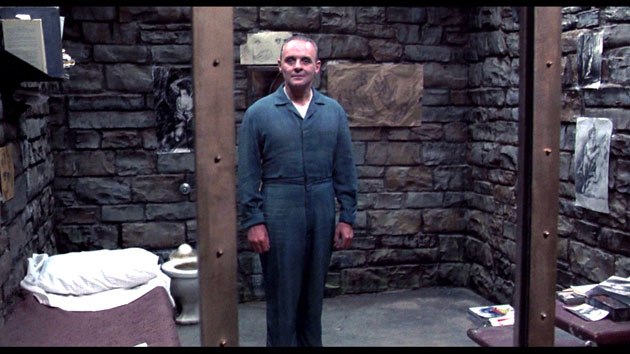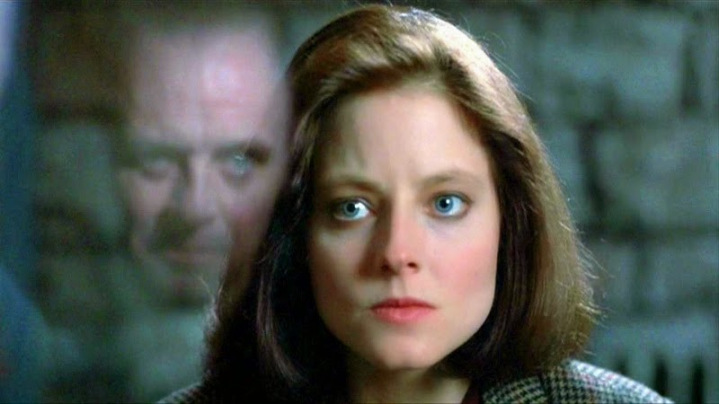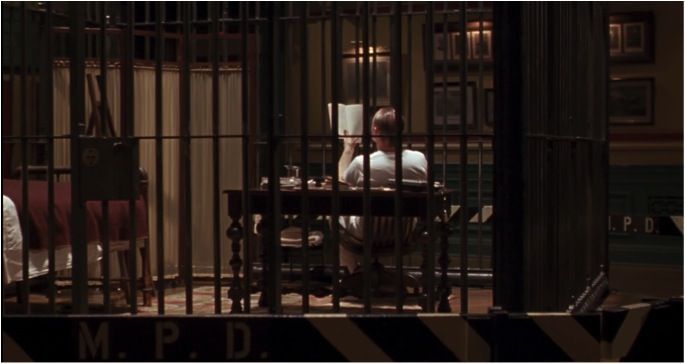Welcome to our Film Frame Friday feature, where we do a close frame reading of a film. We’ve recently covered a couple of modern animated movies in Kubo and the Two Strings and Your Name. This week, to kick off Criterion Month, we’re going into dark territory. We’ll be looking at The Silence of the Lambs—especially focusing on deep readings of all the meetings between Clarice Starling (Jodie Foster) and Dr. Hannibal Lecter (Anthony Hopkins) and the intense psychological character studies they provide. Settle in for a meaty treat and let’s explore everyone’s favorite cannibal.
We’ll be breaking their meetings within the film because they are core to the central constructs of both characters. Utilizing director Jonathan Demme and cinematographer Tak Fujimoto’s brilliant masterwork, we’ll take each scene as an exploration of relationships and the status therein.
Please note: If you haven’t watched The Silence of the Lambs, spoilers ahead.
First and Second Meetings

It’s important to break down Lecter’s role in this film. He does not appear in a lot of it but his scenes provide most of the significant character work being done here. Because there are so few meetings, they are punched up with maximum emotional resonance.
Clarice’s introduction to Lecter is completely startling. She moves toward his cell and there he is—standing upright as though he has been waiting for her. Like she’s a bit of prey and as the predator, he sensed this meeting all along. There are a lot of implications here: Lecter’s size is used to create the larger-than-life literary persona from the books. Clarice is initially somewhat reticent around him and is working to stay on an even playing field.
“Come closer,” Lecter growls, and then he demands to see her credentials.
Much of their scenes are done through way of point-of-view shots. This allows each character unique positioning. Clarice to the left of the frames, Lecter usually on the right. Worth noting, this is usually done to show a rupture between individuals in a shot. Sometimes it is used to this effect but also to show how they present to one another.
She shrinks in stature as the meeting progresses, taking a seat while examining his mind and getting to know the psychological makeup of a vicious, cannibalistic killer. This is a power exchange between the characters. She is opening her space and allowing him to come in. What she finds in him is that he is not so different from herself; despite his actions that prove otherwise, they share a part in the same mental game.
The second meeting turns the tables. Lecter is shrunk down into a corner of his cell. Yes, now he is vulnerable, and we get to learn something of his character. This is a perfect opportunity for Clarice to provide more probing questions. There’s an unsettling frustration and tension in their exchanges here. We’re given suggestions of great abuse in the past, the way history has maladjusted the psyche of his character. Not just a bad guy but a very bad guy who is also mentally intriguing. A psychologist put out of practice by his own macabre habits. A cannibal with some remorse but only in the world of intellect. And now he wants to dine and the meal is of the mind.
Third Meeting

This is where we get a great character shift. The actors’ positioning shows they are true equals. Lecter opens up enough to allow for laughs and to show his humanity behind all of the depravity. The truth is we find him incredibly charming—not simply because Hopkins is charming—but because he connects to some deep-rooted part of our spirit that wants to understand him.
The characters’ relaxed postures imply familiarity and comfort with one another. In a brilliant moment of framing, we see Lecter cannot face Clarice. He must turn away once her own darkness is revealed. Now she has turned the mirror in on himself, and he sees the monstrosity of human behavior. His posture is racked with guilt and fear.
Meanwhile, while divulging her own darkness, Clarice has come to accept Lecter’s own humanity. She sees the good in Lecter that also exists within herself. This great duality is one of the finest examples of character building in films. They understand each other—hell, they are the other person living out a different life.
Lecter finally comes to a position where he’s facing Clarice. His steely gaze reflects through the window of his cell, while his perspective shows a close-up of young, brilliant Clarice. Intricate contrast work is done on the imaging here. Significantly, each encounter has its own unique framing; nothing is added without first providing new value. The film is a masterclass on presenting the great gulf of difference and similarity between its two driving characters and a fascinating psychological study on how we come to interact with pure evil.
Fourth Meeting

This scene takes place in a gigantic room in the Sailors & Soldiers Memorial Hall in Pittsburgh. Art adorns the walls, providing natural framing and line of sight elements. A large zoo-like cage sits in the room’s middle—separating Lecter from the rest of the world. He’s facing away, lounging back in his chair, engrossed in an original Russian language version of Tolstoy. We know that even in his confinement, Lecter remains a man of culture and refinement. He can find more inside a cell than many will find on the outside.
We get a quick swivel of his chair, and he’s staring between bars, right into Clarice’s soul. Notable here is that he’s changed into clinical whites. This, to imply a position of greater authority. He is, after all, nothing if not an impassioned man of the mind.
The scene is relayed like a flirtation. There’s a certain rhythmic exchange and expression of the syllables – Lecter’s “tick, tock, tick, tock.” Yes, they are friendly now. Almost a father-daughter relationship, to fulfill what has been missing in Clarice’s life. But not quite—more significantly, a relationship of the mind.
Here, Lecter begins piecing together his psychological profile of Clarice. The visits have become much like sitting on the couch at one of his appointments. Even caged in, he maintains complete control of his situation and environment. The less he works with, the more he is able to physically exert control over his space. He determines Clarice was always bound to go down this road, a born hero, or one formed very early in her childhood. Close-ups reveal the intense emotional conflicts in their discourse. These extreme emotional outpourings cased in close-up shots convey that the two are connected at some higher philosophical level.
They are no longer different. Clarice has formed her own cell, we see as she recounts an old story. She is as imprisoned by her past as Lecter is by his present. Here is the great crux of the movie: that the good and the bad are not so very different. They are, in fact, closely related and utilize the same psychological profile to meet different needs. These complexities of character development can only be exchanged with the most perfect acting, cinematography and direction. This is paramount to the reason The Silence of the Lambs is broadly considered one of the best films to this day.
As a fun side note, following this meeting, Clarice is escorted out of the room by none other than Night of the Living Dead director George Romero.
Phone Call
The film ends with a phone call between Clarice and Lecter. He has found a new lunch, a victim to cannibalize. This is a hell of a way to end a picture. It shows that despite all of their connection and simultaneous emotional growth, their mental game exists in a place where they have fixed positions. She is, uncommonly for a typical movie, the woman hero who saves women, and he is a great psychological threat that comes in many layers. We’re left with a hanging shot and credits but are filled with a disbelief that any of this is over. This is only the start of a great chess game of the minds.
